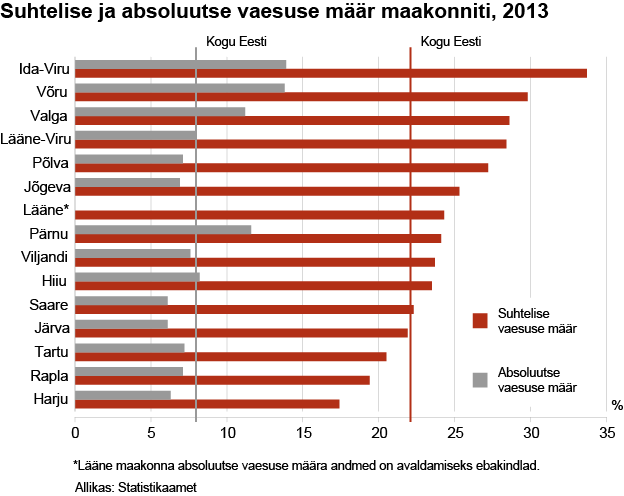Analytics, Education and Science, Estonia, EU – Baltic States, Financial Services, Society
International Internet Magazine. Baltic States news & analytics
Thursday, 25.04.2024, 05:54
Every fifth person in Estonia lived in relative poverty in 2013
 Print version
Print version
Social transfers (state benefits and pensions) helped to prevent falling into poverty, as had they not been included in income, the at-risk-of-poverty rate would have even been 40.7% and the absolute poverty rate 32.6%.
In 2013, a person was considered to be in at-risk-of poverty if his/her monthly equalised disposable income was below 358 euros and in absolute poverty if his/her monthly equalised disposable income was below 205 euros. In 2013, the difference in income between the poorest and richest fifth of the population was 6.6-fold.
The at-risk-of-poverty rate is highest in the case of elderly people. In 2013, 32% of persons aged 65 and over lived in relative poverty. The absolute poverty rate is highest in the case of children and young people (aged 0–24) and in the case of pre-retirement age people (aged 50–64) (10% in both age groups).
The level of education significantly affects the risk of falling into poverty. Among persons with basic or lower education, every third was in the poorest and only every twelfth in the richest income quintile. At the same time, one-third of people with higher education belonged to the richest fifth. Therefore, the at-risk-of-poverty and absolute poverty rates of persons with higher education (14.6% and 4.1%, respectively) were more than two times lower than those of persons with basic or lower education (33% and 10.4%, respectively). A higher level of education is an important prerequisite for the prevention of poverty.
The incomes of Estonians were higher than those of non-Estonians and the risk of poverty was lower for Estonians. In 2013, the at-risk-of-poverty rate of Estonians was nine percentage points lower than that of non-Estonians and the absolute poverty rate four percentage points lower. 19.5% of Estonians lived in relative poverty and 6.8% in absolute poverty, the same indicators for non-Estonians were 28.6% and 11%.

More detailed information can be found in the statistics blog (only in Estonian).
At-risk-of-poverty rate is the share of persons with yearly disposable income lower than the at-risk-of-poverty threshold, and absolute poverty rate is the share of persons with yearly disposable income lower than the absolute poverty threshold. The at-risk-of-poverty threshold is 60% of the median yearly disposable income of household members, the absolute poverty threshold is the estimated subsistence minimum. Equalised disposable income is the total household income, which is divided by the sum of equivalence scales of all household members.
The estimations are based on the Social Survey, which has been conducted by Statistics Estonia since 2004. In 2014, more than 5,800 households participated in the survey. The survey collects data about the yearly income, which is the reason why the survey of 2014 asks about the income of 2013. The yearly income is necessary for calculating the indicators of poverty and inequality. In the case of the income of 2013, the data source changed – in addition to the Social Survey and previously used databases, the data of the Tax and Customs Board were also used.
Social surveys are conducted by national statistical offices in all European Union countries on the basis of a harmonised methodology under the name of EU-SILC.








 «The Baltic Course» Is Sold and Stays in Business!
«The Baltic Course» Is Sold and Stays in Business!

